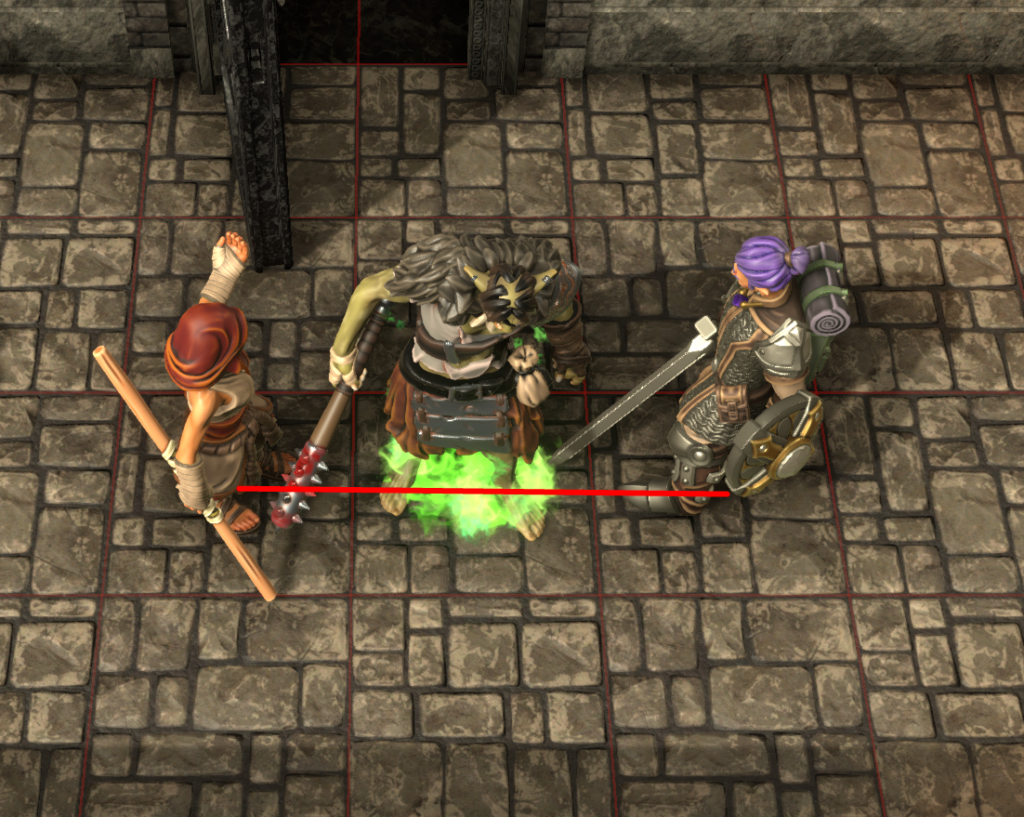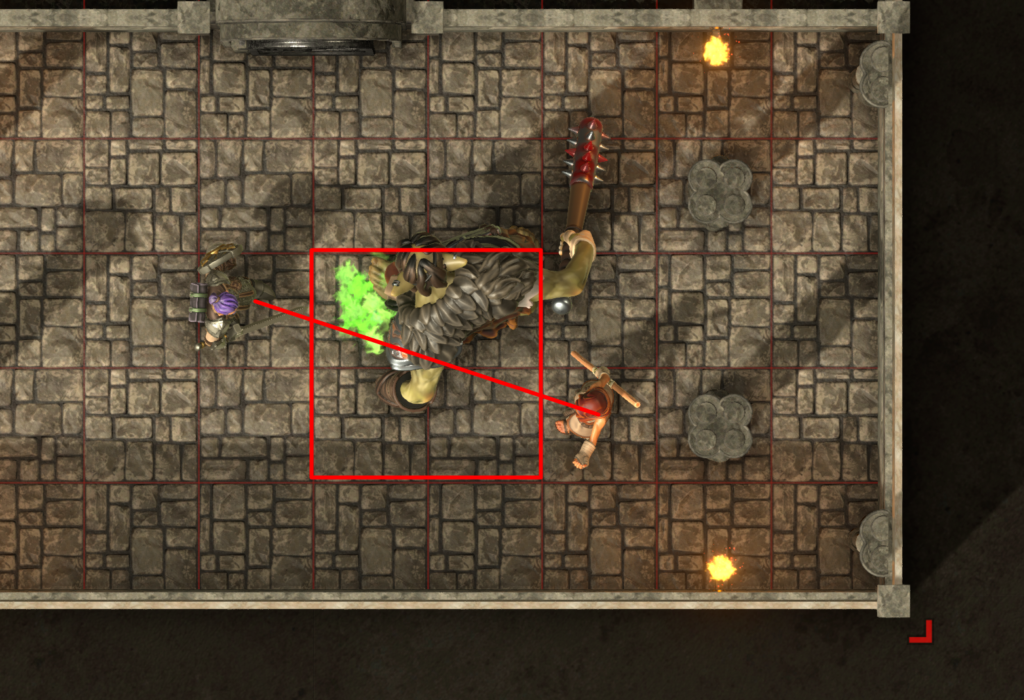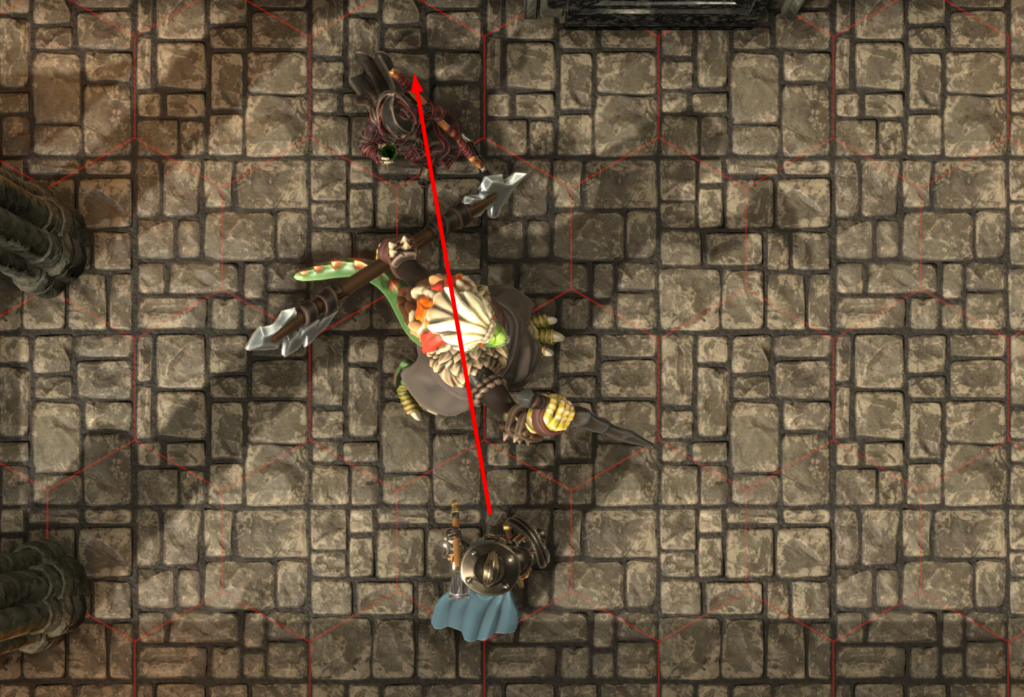
TLDR:
Combat in D&D is very fun. It can also be very dynamic with the right ruleset. One of those rules is Flanking in DnD 5e. Flanking can turn the tide of combat one way or the other and may be too powerful to allow in your game.
In this post, let’s dissect what flanking is, how it works, and some ways to make it even better!
Flanking is an optional rule in D&D 5e. It gives advantage on melee attack rolls if the target is flanked. That means the target has another character posing a threat directly opposite the first attacking character.
In practice, this means that two allied combatants are on opposite sides of the same adversary in combat. The two flanking combatants must both be engaged with the target of the flank. In this case, the enemy is flanked.
First, you need to know that in DND 5e, flanking is an optional rule. As a DM, you don’t need to allow it in your game. If a player challenges you on this, just stand your ground. As a Player, you need to know your DM’s house rules and obey them.
If you decide to include it in your game as a DM, there are many fun ways to try to use this or get your players to use it. Now that we understand flanking rules in 5e, let’s discuss how to use them.
The only way to use the flanking maneuver is by having two allied characters threatening one adversary. They also must be on opposite sides of the adversary. That said, you can accomplish this in a few unique ways.
“Flank” means the side or corner of a person’s or animal’s body (hence the flank steak). You can understand that flanking someone means going on the other side. In a military sense, one army doesn’t necessarily need to be engaged with another to flank it. Two armies on opposite sides of another defending army could be considered flanking.
If you want to have big military actions in your game, think about allowing the flanking maneuver. It can take a simple point-and-click encounter and turn it into a game of much more strategy.
When it comes to monsters, you can incorporate flanking in numerous ways. Probably the most common and simple way is using the tactic when it makes sense for the monster.
For example, creatures that gain the pack tactic advantage on attack rolls like Wolves and some Gnolls would most definitely flank. Velociraptors are another example of a creature that has always been thought to hunt using cunning tactics like flanking.
You could even create a homebrew monster designed to flank.
On the flip side, you could create a homebrew monster who can’t be flanked. Theoretically, creatures with multiple heads like an Ettin or a hydra should be immune to flanking. That would be up to you as the Dungeon Master.
Or you could create a monster that has the thunderstep ability. It would allow the monster to essentially bait and switch your players if they use flanking all the time to grant themselves advantage. Thunderstep allows the target creature to transport themselves out of a sticky situation. It also causes damage to all those around them before they do.
You can see how there are many options to both delight your players and fight against them confidently and securely.
As a player, using flanking is quite simple. All you need to do is coordinate with other players at your table to flank any given monster. If your DM allows, then flanking should be in your mind at all times.
Flanking is especially good if you have a tank and a rogue. The tank will stand in front of the enemy and take as many attacks as possible, absorbing the hits with no problem.
Meanwhile, the rogue will be lurking in the shadows, waiting for their opportunity to dart in and hit the enemy with a Sneak Attack. Sneak Attack gets triggered if the attack is at advantage so you’re covered there. Plus, because the rogue will be rolling at advantage there is a higher chance to snag a Nat 20. The damage just compounds.
As a player, you should be aware that some of Flanking is up to the discretion of the DM. For example, I would say that 2 medium or smaller creatures could not flank a huge-sized Storm Giant. Flanking is supposed to connote a feeling of inescapability and danger. The Storm Giant could just step over the party.
Even on a smaller scale, I’m not sure I would allow two medium-sized PCs to flank a Large-sized Ogre. The Ogre would probably feel capable of escape.
That said, maybe you could persuade your DM if many more PCs are attempting to flank. Then it might become like Gulliver’s Travels and tiny people who tethered him to the ground (if you’ve ever read that story). Overall though, flanking can be used to combat an enemy’s high armor class.
When using a battle map, flanking is a fairly easy affair. To qualify to flank, the two flanking characters need to be on opposite sides of the adversary. To tell if you are flanking, simply draw an invisible line in between the two attacking characters. If the line goes through the center of the adversary, then you are flanking.
If you use a square grid, then that imaginary line can’t pass through two adjacent sides of the adversary’s grid space. Let’s say the enemy takes up a one-by-one space. In that case, the line passing between the two attacking players must pass through opposite sides of the space.

Instead, let’s say you have a creature that is a large creature and takes up a 2×2 grid space. Then the line between the flanking creatures cannot pass through a side that is perpendicular to the side either of the creatures is on.

When you have a hex grid, it works more or less the same, with some leeway either way. Generally small or medium creatures will take up 1 hex space. The two flanking creatures must be on opposite sides of the hex space. The invisible line between them cannot pass through the two sides in between the flanking creatures on either side of the flanked creature.

If you have a large creature, they will likely take up 3 hex spaces in a loose triangle. In this case, the invisible line must go through the equivalent of 2 hex spaces. If it doesn’t then it is not flanking.

You can scale both of these up to huge or bigger creatures.
When in doubt, ask your DM, or if you are the DM, just make a judgment call.
Some people choose to play without a tactical grid and instead use the Theater of the Mind! That’s fine, it just takes a lot of the tactics out of the fight.
One doesn’t need to position creatures to benefit from a flanking maneuver. Instead one can say, “I move this character to flank the enemy in conjunction with this other character.”
The DM will still be able to rule on it. Flanking wouldn’t make much sense if there is difficult terrain or the situation wouldn’t allow it.
That said, gaining the flanking advantage while using the theatre of the mind is generally much easier. Because of this, some DMs who only use Theatre of the Mind don’t allow flanking. In this case, it’s just too easy for both sides of any conflict just to get advantage on any given attack.
If you are a player and your DM does allow you to use flanking, please try and add a little flair to your flank.
Don’t just say, “I flank the gnoll”.
Explain how and why.
“I approach its flank, brandishing my Glaive and yelling curse words in Primordial to get its attention. I do this to create an opening for my ally.” While mechanically you are just saying, “I flank”, narratively, you say so much more. And in a way you are telling your DM, “I appreciate you and want to help make this experience fun for everyone.”
As I’ve already mentioned, there are some optional flanking rules where flanking just doesn’t make sense as a mechanic. The DM(maybe that’s you) will have the final say as to whether or not the flanking maneuver works. In my opinion, they won’t tell you that until you have tried it if they are a good DM.
One example would be in a situation with very low visibility. If you are fighting monsters in a thick cloud bank, it would be difficult to gain the advantage of flanking. Visibility for every creature would be too low.
Similarly, the DM would make a judgment call if the encounter involves difficult terrain. A great example is If the combat encounter is happening on a frozen lake. In that case, everyone has a chance of slipping and falling. I would consider that a situation where flanking might be impossible.
In that case, likely, anyone who attacked would have disadvantage. If you already have disadvantage you shouldn’t be allowed to flank. But then again there might be some situations.
When it comes to Dungeon Mastering, as with most things in life, the answer is often frustratingly, “It depends”.
Now there is a clear and distinct difference between flanking and positioning. Flanking is positioning a creature relative to another creature to gain an advantage when attacking. Positioning is moving around the encounter to gain tactical advantages with or without any explicit mechanical benefits.
An example of positioning might be the monk who disengages so they can run and jump behind a half-fence to gain partial coverage.
Another example of positioning would be a dwarf paladin who skirts around an enemy. In this case, he avoids provoking an opportunity attack but moves to be close to an ally who needs healing.
Positioning and flanking are related but are not the same thing. Both are very powerful tools to use in the world of D&D.
Now comes the juicy part.
The combos!
In D&D there are many ways to mix and match features, skills, and mechanics. Let’s talk about a few of the combos that pair very well with flanking. But first, let’s talk about some combos that do not pair well.
First, know that flanking does not work at range. If you have an ally on the opposite side of an enemy attacking at range is allowed. You won’t get flanking. You need to be up close and personal.
Next, know that flanking works with engaged combatants whether they use melee weapons or melee spell attacks. You could even use ranged weapons while engaged, but generally, you will still have disadvantage. So it’s probably not even worth it.
Now, technically speaking, flanking is already a very powerful and simple combo. Both flanking creatures will get an advantage on their attacks… all of their attacks. If you have two monks flanking one creature, that could be a very powerful combo. Each monk could attack so many times in one turn and all of it was at advantage.
Flanking gives advantage to attacks, so pairing flanking with features that already give advantage isn’t a good idea. Flanking with a barbarian and then recklessly attacking wouldn’t be smart because it gives you no added benefit.
So when you create these combos, try to find things that trigger when you have advantage.
I already mentioned the rogue. Having advantage triggers Sneak Attack which dramatically increases the output of damage from the rogue. Add that to the fact that they get advantage on the actual attack and you have a very powerful attack.
Another class to flank with would be our friendly Paladin from an earlier example. Your goal is to fish for crits, using the advantage of flanking. Then whenever you crit, just lay down a nasty smite.
You can take down enemies very quickly using this tactic. It works best on single enemies though.
Monks and fighters are also very good characters to flank with because they can get so many attacks. Whenever you get a blanket advantage on every attack in a turn, you should try and attack as much as possible.
Using a monk would also be a good idea if the opponent can disengage. Monks generally have a lot of movement. This allows the monk to get into engaged range with the target quickly.
Finally, a druid’s wild shape could also be a really powerful addition to the flanking combo. Depending on what the druid chooses, the advantaged attack could be very powerful. For example if the druid wild shapes into some sort of poisonous creature like Giant Snake. In that case, the advantage can come in handy to ensure the hits land, giving the druid the best chance to poison the target.
Overall, it’s my opinion that flanking is a bit overpowered but that’s what makes it so fun. Whether you are the DM or the player you can flank creatures by putting two allies on opposite sides of the target. With the other tips I’ve shared, you’ll best know how to combo with flanking and use it to its utmost.
If you are the DM, consider adding flanking to your gameplay. This isn’t just just so your players can use it against you, but so you can use it against your players too. Flanking adds a tactical aspect to gameplay that can make having battle maps much more fun and dynamic. Let me know in the comments whether or not you add flanking into your game and why.
Copyright Monsters.Rent 2023